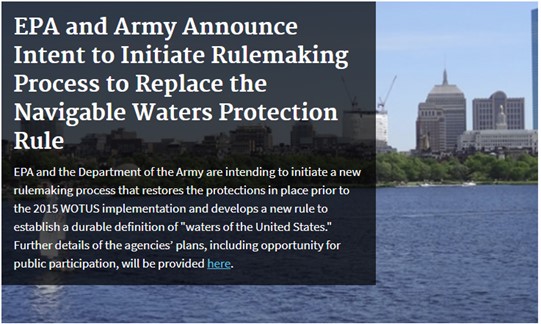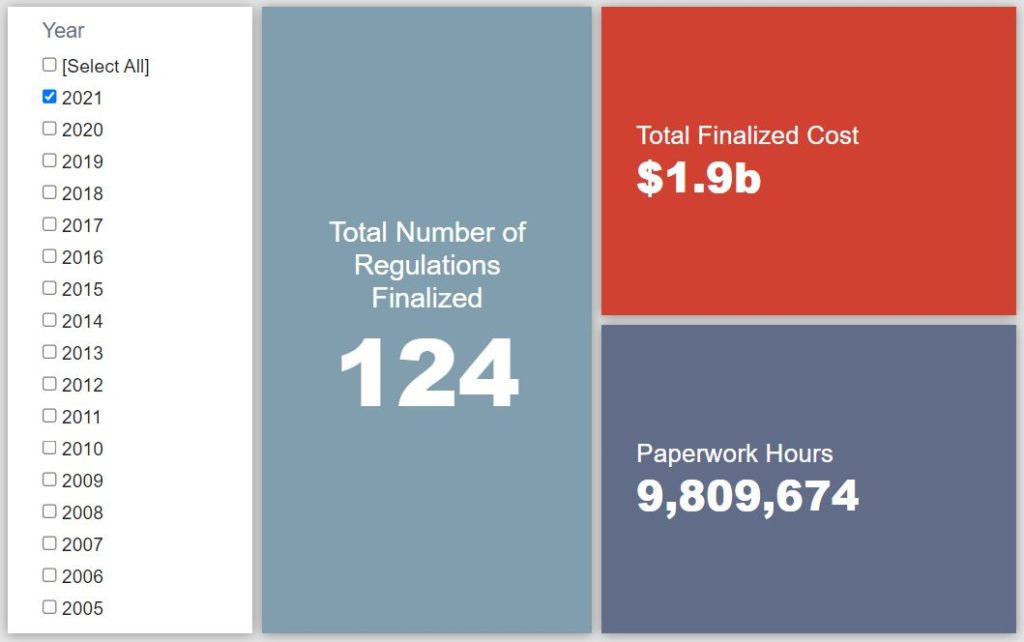Week in Regulation
June 14, 2021
Gun Brace Measure Leads Relatively Active Week
After a couple of fairly quiet weeks, last week saw a noticeable uptick in activity in the Federal Register. A Department of Justice (DOJ) proposal on reclassifying certain firearms based upon their brace setup provided the bulk of costs and paperwork. A rule regarding pilots’ records also got in on the fun. Additionally, the Biden Administration released its first formal regulatory agenda. Across all rulemakings, agencies published roughly $296.5 million in total net costs and added 3.6 million annual paperwork burden hours.
REGULATORY TOPLINES
- Proposed Rules: 37
- Final Rules: 87
- 2021 Total Pages: 31,375
- 2021 Final Rule Costs: $1.9 billion
- 2021 Proposed Rule Costs: -$14 billion
NOTABLE REGULATORY ACTIONS
The DOJ proposal regarding “Factoring Criteria for Firearms With Attached ‘Stabilizing Braces’” was the most consequential rulemaking of the week. The proposed rule would make a series of changes to the process that determines whether a firearm “would be considered a ‘rifle’ or ‘short-barreled rifle’ under the Gun Control Act of 1968 (GCA) or a ‘rifle’ or ‘firearm’ subject to regulation under the National Firearms Act (NFA).” This determination affects how heavily a particular firearm could be regulated. This updated process would add significant administrative burdens as well. DOJ estimates that the action could yield $125.7 million in costs and impose an additional three million hours of paperwork.
The most notable final rule of the week was the Federal Aviation Administration’s (FAA) rule regarding the “Pilot Records Database.” The rule: A) establishes an electronic database of pilot information to facilitate the sharing of data across operators and B) requires various previously uncovered aircraft operators to regularly update that database. The additional administrative filings included in such a system brings total net costs of $67 million and roughly half a million hours of new paperwork.
Finally, the Biden Administration released its first “Unified Agenda of Regulatory and Deregulatory Actions” (Unified Agenda) detailing its regulatory priorities for the coming year. Click here for a closer look at some of the Unified Agenda’s main highlights.
CONGRESSIONAL REVIEW ACT UPDATE
On March 23, the first joint resolution of disapproval under the Congressional Review Act (CRA) of this term was introduced. CRA resolutions essentially seek to wholly rescind specific final rules within a set timeframe. The significance of these resolutions is discussed further here. In the interest of providing a public accounting of the potential economic impact of these actions should they pass, the American Action Forum (AAF) will provide a regular update of the rules being targeted and a concise summary of each rule’s purpose, economic impact, and why opponents may be targeting it. The latest update of any note is that House version of the resolution on the “methane rule” passed through the Energy and Commerce Committee and is currently slated for a full floor vote in coming weeks. The Senate version passed on April 28.
TRACKING THE ADMINISTRATIONS
As we have already seen from executive orders and memos, the Biden Administration will surely provide plenty of contrasts with the Trump Administration on the regulatory front. And while there is a general expectation that the new administration will seek to broadly restore Obama-esque regulatory actions, there will also be areas where it charts its own course. Since the AAF RegRodeo data extend back to 2005, it is possible to provide weekly updates on how the top-level trends of President Biden’s regulatory record track with those of his two most recent predecessors. The following table provides the cumulative totals of final rules containing some quantified economic impact from each administration through this point in their respective terms.
![]()
Since the DOJ “Stabilizing Braces” action was merely a proposed rule, its administrative burdens are not included in this week’s tally. Nevertheless, the DOT Pilot Records rule did apply. It was the primary driver of the roughly $80 million in costs and 530,000 annual paperwork burden hours from final rules over the week. As such, the Biden Administration saw the most active week of the three administrations covered here. There was little-to-no shift in either the Trump or Obama regulatory ledgers.
THIS WEEK’S REGULATORY PICTURE
This week, the Biden Administration plans to rescind and replace a major water protection rule.

On June 9, the Environmental Protection Agency and the U.S. Army Corps of Engineers (the agencies) announced that they would repeal the Trump Administration’s Navigable Waters Protection Rule, the most recent effort by the agencies to define “Waters of the United States” (WOTUS) under the Clean Water Act (CWA).
The definition has been anything but clear since the passage of the CWA in the 1970s. The term’s definition is important because it determines where the federal government can prohibit, or require permits for, certain discharges or activities such as land development. While the agencies have issued what they presumed to be clear definitions, courts have struggled to ascertain exactly how far Congress intended to extend the federal government’s reach.
The issue is also politically charged, with Republican administrations seeking to limit the reach of federal jurisdiction while Democratic ones aim to extend it. The Obama Administration utilized a Supreme Court decision to issue an expansive rule in 2015. The Trump Administration countered with a revised definition of their own that limited the definition to only the most obvious federal waters in 2020.
Now the Biden Administration will take a crack at it. It will, however, do so through unconventional means. Rather than go through a rulemaking effort to rescind the Trump Administration’s rule, which would take considerable time, the DOJ instead will ask a federal court to remand the rule to the agencies due to ongoing litigation over the Trump Administration rule. If the court does so, and there is little reason to think it wouldn’t since the Biden Administration will not defend the Trump rule, then the agencies face a shorter timeframe to rescind the rule.
TOTAL BURDENS
Since January 1, the federal government has published $11.9 billion in total net cost savings (with $1.9 billion in new costs from finalized rules) and 1 million hours of net annual paperwork burden reductions (with 9.8 million hours in increases from final rules).












